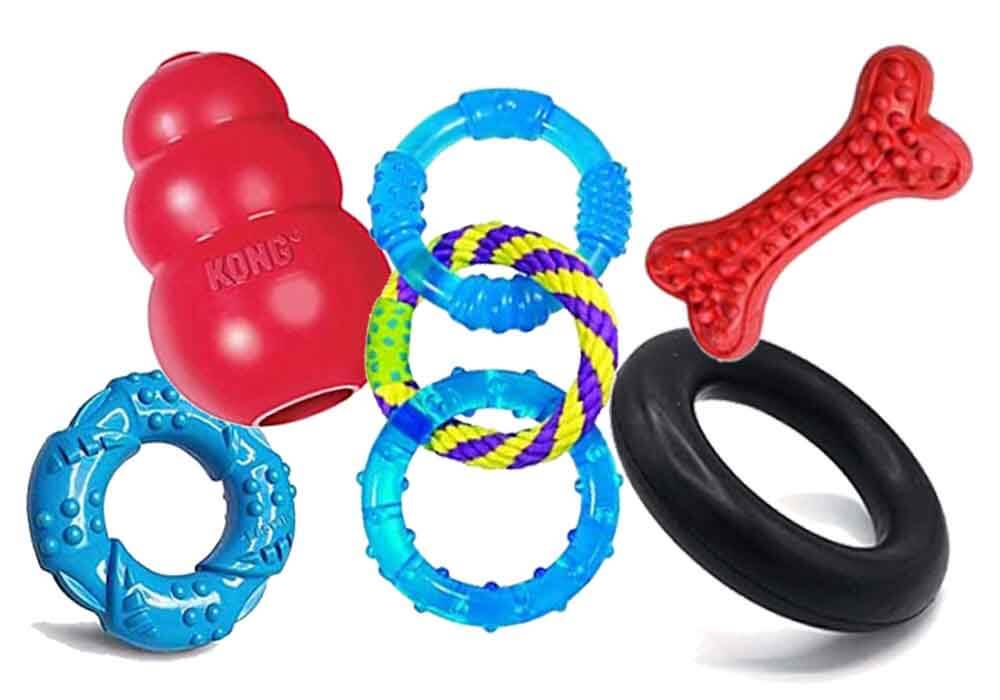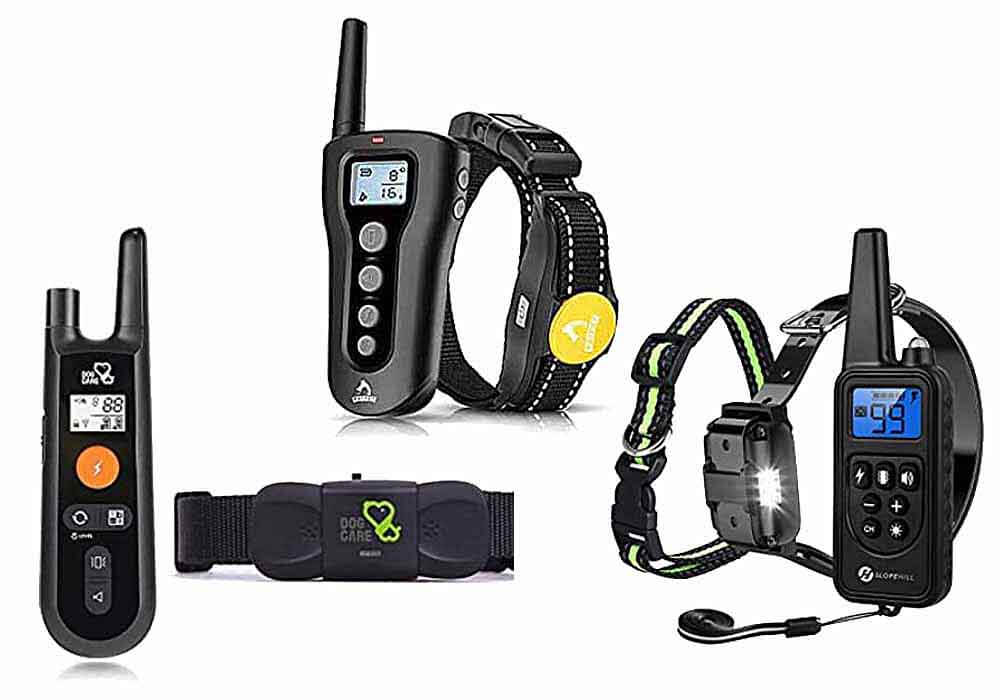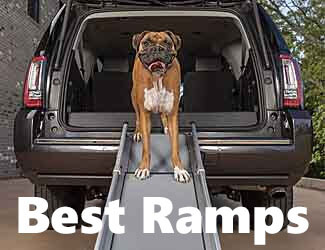Best Harness For A Mastiff
Helpful Sizing Tips And Recommendations
by Ken Alden
Owning a near-200 pound dog like a Mastiff means giving up the
typical leash/collar combo and opting for a large and durable harness. A proper
harness is the best way to keep your Mastiff under control while on a walk
while also reducing neck injuries if he happens to lunge or take off in a
sprint.
Selecting the best harness for a Mastiff means a properly sized harness for your pooch which requires accurate measurements of his neck, chest, and weight. Also, you should be ensuring that you’re weighing the pros and cons of each type of harness and selecting the one that’s appropriate for Mastiffs as well as your dog specifically.
Not all harnesses are designed the same and not all harnesses will
hold up to the pure brute strength of your Mastiff. You need to thoughtfully
consider each type of harness before making your final decision.
Go Directly To Our Harness Recommendations Here...
For Mastiff Puppies
For Mastiff Adults
Types Of Mastiff Harnesses
All harnesses have the same intentions: Keeping your dog under control while he’s on his leash. Yet, there are several different types of harnesses that all provide their own benefits and are ideal for different dog breeds and behaviors.
Harnesses are typically identified by their clip location,
physical shape, and how your dog will enter the harness. There are practically
limitless combinations of each of these factors, so it’s highly unlikely that
any two harnesses are exactly the same.
Harness Clip Location
The actual location where the leash is hooked will play a huge role in how well your Mastiff is controlled while he’s on his leash. Here are two different clip locations and how they can make a difference when it comes to walking your Mastiff.
- Front Clip. These are most highly preferred when it comes to keeping your Mastiff under control on his walk. Because the leash is connected near his chest, your Mastiff won’t be able to pull as much and you’ll have a much more leisurely walk.
- Back Clip. This is the traditional type of dog harness and it has the leash connecting to the harness somewhere on your Mastiff’s back. Though these harnesses tend to be a bit stronger, your Mastiff is much more likely to pull when he feels resistance at his back.
If your goal is to control your Mastiff and keep him from running
off or lunging while he’s on the leash, a front clip would be the best type of
harness. A lunging or sprinting Mastiff can be extremely intimidating and front
harnesses will allow people to see that your Mastiff is well-behaved and
gentle.
Physical Shape
The actual way that the harness conforms to your Mastiff’s body
plays a huge role in how well the harness fits and keeps your Mastiff behaved
during a walk. Here are three different types of harness shapes that you might
want to think about.
- X-Shaped. These are some of the most popular harnesses. Due to the strap that sits vertically on your Mastiff’s chest, there is a greater risk of injury when your dog pulls on his leash. It can cause irregular pressure on the chest and associated muscles, which could lead to injury in the long-term.
- H-Shaped. These harnesses wrap around your dog’s neck and chest separately and then connect with a single strap along your dog’s back. No matter how hard your dog pulls with this type of harness, he won’t be getting too far and he won’t be risking any type of injury.
- Y-Shaped. These harnesses are similar to the H-shaped in terms of where the harness straps around your dog’s body, but they connect at one central point at the top of your dog’s back. The physical design of this type of harness makes it very unlikely that your Mastiff will pull while he’s on the leash.
The Y-shaped harness is the best choice for dogs that are strong
or tend to pull while on their leash. This type is perfect for Mastiffs given
their large size.
Entry Points
Putting the harness on can be quite the battle if your Mastiff
loves to mess around and treat everything like it’s playtime. If he tends to
make it difficult to put a harness on, you’ll want to make sure that you’re
getting a harness that’s easy to put on and remove. Here are different types of
harness entries.
- Slip-on. These harnesses easily
slip on around your Mastiff’s neck and are then hooked around his back. They
don’t require much effort to put on and take off.
- Step-in. These harnesses require your Mastiff to step into two leg holes and are then hooked around the back. If your Mastiff is reluctant to work with you, you might have to individually pick his legs up to put them in this harness.
Slip-on harnesses might be the best option, especially if your
Mastiff tends to be a bit difficult. They’re much easier to put on your Mastiff
and they don’t require you to lift his legs to be able to put it on.
Picking The Right Size Harness For Your Mastiff
You know you need a large harness for your Mastiff, but you’ll need more specific data to help select the harness that fits your Mastiff best. Otherwise, you might end up with a harness that’s so large that he can slip out of it or too small that it chafes and scrapes his skin.
To get your Mastiff’s measurements, you’ll need a cloth measuring tape and
possibly treats to keep your Mastiff still long enough to get the measurements.
You’ll then follow the tips below for measuring your Mastiff’s neck, chest, and
weight to help you select the correct size.
Neck Measurements
To get the proper neck measurements, you’ll need to measure at the
correct location on your Mastiff’s neck.
The ideal neck measurement would take place at the thickest part of your Mastiff’s neck.
You’re looking to measure exactly where you would keep his collar,
so it might be easier to take off his collar and measure the length of it.
Chest Measurements
The chest is a little more difficult to measure because your Mastiff will probably be unable to sit still while you’re trying to get your measurements. This is where treats might come in handy!
The chest measurement will take place right behind your Mastiff’s front legs and wrap all the way around over his shoulder blades.
This is essentially the widest and largest area of your dog’s body.
Weight
Weighing a small dog is easy, but heavy dogs like Mastiffs cannot be weighed on the average bathroom scale. You’ll need to be a bit more creative when it comes to weighing your Mastiff.
The easiest option would be visiting your vet’s office and having your Mastiff weighed. Most vets will allow you to do this for free and it will provide you with the most accurate weight.
But, why does weight matter when it comes to harnesses?
Harnesses aren’t only designed around the physical size of your dog, but also the likely strength. A larger dog would need a larger harness, which in turn would have stronger material and thicker straps.
It wouldn’t make much sense to make an extra small harness strong
enough to withstand the force of a Mastiff.
Putting It All Together
All harness companies have different sizing, so you need to make sure that you know all of your Mastiff’s measurements before ordering a harness online or heading to the pet store.
That means knowing the chest measurement, neck measurement, and weight.
When you’re looking at different harnesses, you might notice that your Mastiff’s measurements match in one area but not another.
Always go bigger!
For example, if your Mastiff meets the weight requirement and chest measurement of a large, but his neck measures as an extra-large, you should err on the side of caution and go for the extra-large.
There’s always room for adjustments and you can make the harness
smaller, but you can’t make it bigger than it physically is.
Best Harness For
A Mastiff Puppy...Ones We Like
Buying a puppy harness is much different than buying a harness for an adult Mastiff. When you purchase a harness for your puppy, you’re typically using it to teach him how to walk properly on a leash without him becoming injured.
That means you’ll have to look for special features when you’re
picking out a harness fit for your Mastiff puppy. You’ll want to select a
softer material for instances where your Mastiff puppy is a bit out of control,
but you’ll also want a product that’s durable enough for any Mastiff.
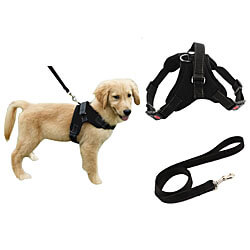
FakeFace Heavy Duty Adjustable Puppy Safety Harness
From Amazon.com this harness is great for teaching your new Mastiff puppy how to walk on a leash! The harness is easily strapped on and wraps nicely around your Mastiff’s neck and chest to keep him contained on his first walk. This harness is lined with soft padding to protect when pulling.
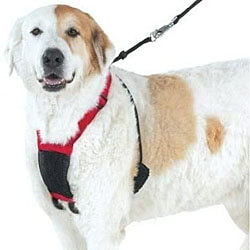
Yuppie Puppy Anti-Pull Mesh Harness
From Amazon.com this anti-pull harness is designed to teach your Mastiff not to pull when he’s learning to walk nicely on a leash. It comes with non-intrusive thin padding that’ll keep your Mastiff under control without hurting him in the process. This harness offers the ideal combination of comfort and durability.
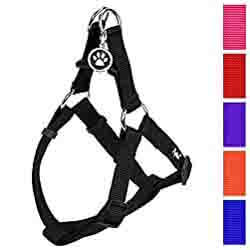
PUPTECK No Pull Dog Harness
From Amazon.com this harness provides maximal security when your Mastiff puppy is learning to walk on his leash. The harness comes with heavy-duty clips to keep your Mastiff with you at all times as well as a center chest strap to help keep your Mastiff as controlled as possible while he’s on the leash!
Best Harness For A Mastiff Adult...Ones We Like
Now that your Mastiff is as big as he’ll ever be, you need to select a harness that’s capable of withstanding any amount of force that he can exert. Given his incredible size, the first thing that you’ll look for is a harness that’s large enough to fit comfortably around your Mastiff’s neck and chest.
Additionally, durability should be one of the major features that
you value. That means selecting a harness constructed of a strong and resilient
material that won’t tear, rip, or break when your Mastiff pulls or lunges. Keep
in mind that some of these harnesses have weight limits that might not fit
larger Mastiffs.
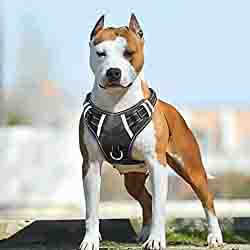
BABYLTRL Big Dog Harness
From Amazon.com the extra-large version of this harness not only will fit your adult Mastiff well, but it’s also incredibly easy to put on and take off with the simple click of a buckle. The vest portion of the harness is soft enough to keep your Mastiff safe when he pulls but durable enough to keep him contained when he wants to run!

Rabbitgoo Dog Harness
From Amazon.com this is the perfect harness for training your Mastiff to walk nicely on a leash without pulling. The harness comes with two simple buckles for easy removal and two extremely durable chest traps to help control your Mastiff when he gets a bit wild when he’s on his nightly walk.

WINSEE Dog Harness No Pull Pet Harness
From Amazon.com this extra-large model offers reflective features throughout the design to provide adequate safety when you’re walking your Mastiff at night. It also comes with a handle on the back to help you to control your Mastiff if he gets a little out of hand or too excited! This product comes with a matching collar.
Frequently Asked Questions...
Is a harness or collar better for a Mastiff?
Your dog should always be wearing a collar to display your contact information in case he gets loose and needs to be returned to you.
However, you should only be walking your Mastiff on a harness.
When you use a collar to walk your Mastiff, you’re applying a lot of pressure to his neck. If he decides to pull or lunges in another direction, the pressure around his neck can increase and cause severe injury.
Harnesses apply pressure to the back or the chest and limit the desire to pull, which makes them the perfect tool for walking your dog.
Do harnesses stop your Mastiff from pulling?
Some can!
The best type of harness to prevent your dog from pulling would be a front clip harness. When your dog does not feel resistance at his back, he’s less likely to take off in a sprint and pull.
However, the harness won’t stop his ability to pull and that’ll require training on your part to correct that behavior.
Is it okay to keep a Mastiff on a harness at all times?
You can, but you shouldn’t.
The major reason is that it’s uncomfortable for your dog. You might not feel like putting the harness on and taking it off every time you take your Mastiff for a walk, but it can irritate your Mastiff’s skin and make him feel uncomfortable.
Why are harnesses used on Mastiffs?
Harnesses are usually used because they’re much safer and less likely to cause injury.
They disperse the dogs weight/mass to it's whole upper body rather than just to it's neck area.
When harnesses are used, you’ll have much more control when your Mastiff’s on his leash and the pulling won’t seem as intense as it usually does.
Some even attempt to prevent pulling altogether!
Can a Mastiff wear a collar and a harness at the same time?
Yes!
Your dog should be wearing his collar at all times, but you should be using a harness when he’s on his walks. Just don’t connect the leash to the collar as well.
Conclusion...
It’s practically a necessity to get your Mastiff a great harness, but you need to put in some extra effort to make sure that it’s a high-quality product that can handle the force of a Mastiff. There are quite a few steps that you should take when it comes to purchasing a harness for your Mastiff. Here are some tips.
Get his weight, chest, and neck measurements before you even begin your search.
Make sure the harness is durable and suitable for large dogs like Mastiffs.
If your Mastiff tends to pull while on a leash, lean more toward a front-clip harness.
Always use a harness!
Return to the top of this Best Harness For A Mastiff page

About the Author...
Ken Alden, a dedicated Mastiff owner for over eight years, is acclaimed for his expertise in care, grooming, and training. Read more About Me and my dog Shadow.
- Mastiff Guide Home ›
- Best Mastiff Products ›
- Best Harness For A Mastiff

